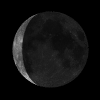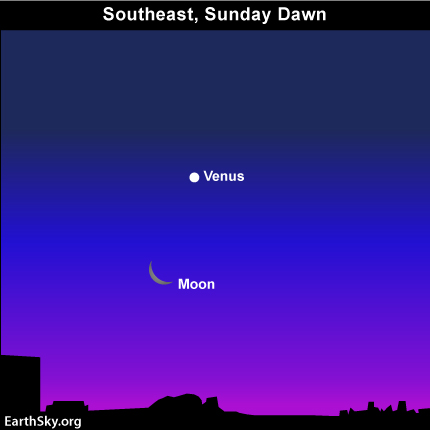Courtesy of EarthSky
A Clear Voice for Science
Visit EarthSky at
www.EarthSky.org

 Wake up before sunrise tomorrow (Sunday, January 30) to see the moon and the planet Venus – the two brightest orbs of nighttime – lighting up the dawn and predawn sky. Our sky chart shows the sky scene as viewed from North America. Elsewhere around the world at this hour, expect the waning crescent moon and Venus to be positioned a little differently in your sky.
Wake up before sunrise tomorrow (Sunday, January 30) to see the moon and the planet Venus – the two brightest orbs of nighttime – lighting up the dawn and predawn sky. Our sky chart shows the sky scene as viewed from North America. Elsewhere around the world at this hour, expect the waning crescent moon and Venus to be positioned a little differently in your sky.
Still, it hardly matters. In the wee hours tomorrow, simply look eastward – in the general direction of sunrise – for the lunar crescent. Near the moon, you will see Venus as the most brilliant star-like object in all the sky.
Of course, when we say that the moon and Venus shine close together, we really mean they occupy nearly the same spot on the sky’s dome. The moon and Venus are not actually close together at all. The moon, our closest celestial neighbor, lodges 1.3 light-seconds from Earth. Venus, the 2nd planet outward from the sun, presently resides some seven light-minutes from Earth.
Light travels at 300,000 kilometers (186,000 miles) per second. That is about 18,000,000 kilometers (11,000,000 miles) per minute. Can you calculate the approximate distance of the moon and Venus, given that the moon lies 1.3 light-seconds away and Venus at seven light-minutes?
If you have binoculars, grab them. If you are up at the crack of dawn or earlier, look for the soft glow of earthshine on the nighttime side of the moon. Watch for the moon and Venus to shine together in the dawn and predawn sky tomorrow, on Sunday, January 30!
When can you see earthshine on a crescent moon?
Written by Bruce McClure
Astronomy Picture of the Day from NASA/JPL
U.S. Naval Observator Astronomical Information center
The York County Astronomical Society
 Print This Post
Print This Post








